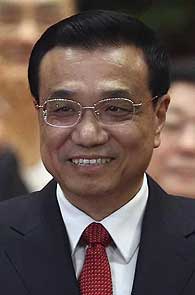 The Chinese premier’s visit may be considered moderately successful, which has covered a profusion of convergent ideas while leaving many more areas of divergence untouched, says Sana Hashmi.
The Chinese premier’s visit may be considered moderately successful, which has covered a profusion of convergent ideas while leaving many more areas of divergence untouched, says Sana Hashmi.
Notwithstanding the recent Ladakh stand-off, the newly-appointed Chinese Premier Li Keqiang Chinese Premier Li Keqiang visited India from May 19-21. The media and the diplomatic community of both countries have been upbeat about the visit. The visit also indicates that the new leadership of China has started attaching greater importance to its southern neighbour.
Premier Li brought along a strong delegation for his three-day Indian visit. The two sides have inked eight agreements to facilitate cooperation on issues of mutual interest, viz., trade, culture and water resources.
The main purpose of the visit, as stated by Li himself, is to increase mutual trust, intensify cooperation and join hands in facing the future together. China views India as a potential economic partner and a huge market which is evident from the fact that primary focus of the visit is, more or less, restricted to trade and investments aspects.
India-China trade reached $ 66 billion in 2012 and both the countries have pledged to achieve the $ 100 billion mark by 2015. However, India is concerned about the overall trade imbalance which is heavily tilted in favour of China.
In that regard, New Delhi and Beijing have agreed to collectively address the concerns. Li’s visit is seemingly giving a new direction to India-China trade ties that is capable of overcoming prickly issues arising over time. Thus, the first meeting of India-China CEO Forum was held during the visit in order to give a further fillip to macro-economic coordination.
Although the main focus of the visit was on strengthening trade relations and enhancing multilateral cooperation at various international fora, their bilateral ties are still marred by more than half-a-century old boundary dispute.
The recent military deadlock at Daulat Beg Oldi, where Chinese platoons entered 19 km inside Indian side of Line of Actual Control and established tents for three weeks, has been a major setback in bilateral relations. The reason for such an action by Chinese troops is still subject to speculation.
However, such an unpleasant incident has generated debates in the Indian corridor of power about feasibility of being at peace with China.
Premier Li’s visit seems to have pushed the boundary issues to the rhetorical level, to say the least. The boundary discussion didn’t figure much in the agenda, details of even that aren’t yet available in the public domain. Moreover, the visit, which seems a lost opportunity for India on the boundary question, couldn’t meet the expectations of those who believe in India-China bonhomie.
The issue which should have been given prime importance in meetings with Li and in the joint communiqué, failed to figure high in the list. Pushing such an issue under the carpet would pose serious challenges to India’s national security in coming years.
It is imperative to note that both countries were in somewhat similar embarrassing situation in 2006 when Chinese envoy to India Sun Yuxi, in his official pronouncement, laid Chinese claim of sovereignty over Arunanchal Pradesh. The statement came just before the then Chinese President Hu Jintao’s first ever state visit to India in 2006. The DBO episode, or even the 2006 proclamation of Sun Yuxi vis-à-vis eastern sector, can be seen as an indication towards rigidly unaccommodating stance of China on the McMahon Line.
No other event could have provided a better platform than Li’s current visit to mend the fences between India and China. Indubitably, Li’s visit had the potential to get the relations back on track provided that Indian leadership shunned its ad-hoc approach vis-a-vis the boundary dispute.
It is beyond doubt that the visit failed to carve out a strategy to address grievances with respect to long-standing boundary dispute. While proponents of India-China friendship find enough reasons to feel good about bolstering economic ties, a lot needs to be accomplished to safeguard the relations from the simmering heat of differences on demarcation of Sino-Indian borders.
However, it seems the India-China leadership has somewhat different stances on the progress of resolution of the dispute. As mentioned in the joint statement, while both India and China seem content over the work done by the Special Representatives of the two countries on the boundary question and perceive the outcome of Working Mechanism for Consultation and Coordination on Border Affairs as fruitful, Indian leadership has expressed concerns about prolonged border dispute and the recent standoff.
Though Manmohan Singh emphasised on the importance of maintaining peace and tranquility at the border and affirmed that without maintaining peace at the border, the overall relationship between the two countries is bound to suffer as concrete steps regarding the dispute was not transpired.
Interestingly, the Chinese side was more apprehensive of Tibetans using Indian territories for holding anti-China protests. Premier Li stressed on India and China’s emergence as new pivots of the world economy; however, the point to be noted is that without resolving the border dispute, it will eventually be beyond their reach to even walk a mile together.
Intriguingly, Li’s visit is regarded by a certain section of Indian media as ‘landmark’, which is an overstatement. Like most of the other previous state visits, this one too focused on strengthening economic cooperation and establishing people-to-people contact. It may be considered rather moderately successful, which has covered a profusion of convergent ideas while leaving many more areas of divergence untouched. The visit might be a grand success for China but certainly not for India given that not many issue areas, except the one concerning Brahmaputra river, are to India’s advantage in the long run.
In a way, for China, the visit was timely and crucial as Manmohan Singh will be on a four-day state visit to Tokyo from May 27. China and Japan are at loggerheads vis-à-vis Daioyu/Senkaku Islands. One may argue that China is using economic diplomacy to convince the Indian leadership about its ‘peaceful development’, and stop India from inching closer to the US and Japan.
Sana Hashmi is an associate fellow, Centre for Air Power Studies










